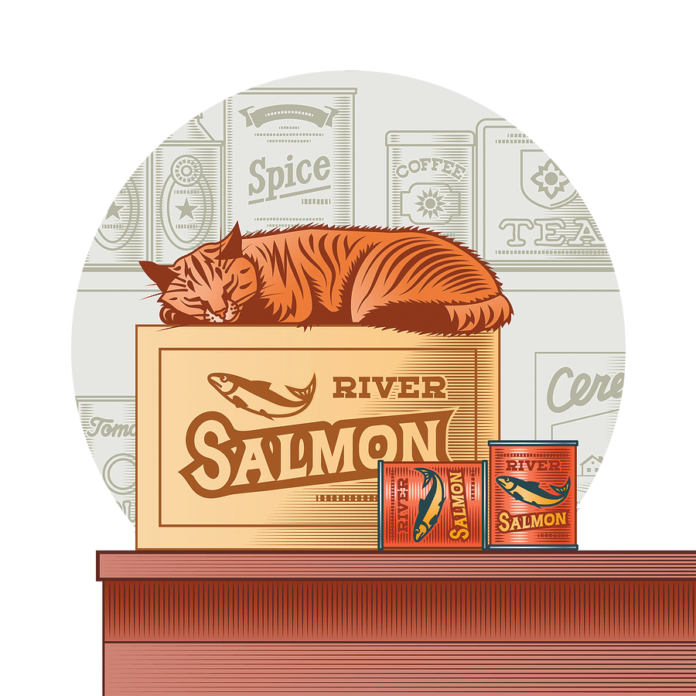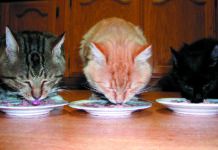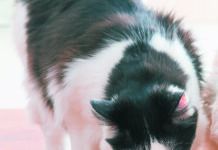We all want to feed our cats as nutritiously as possible, but many owners’ earnest efforts are misguided. Even with the best of intentions, they end up choosing their cat’s diet on faulty assumptions. Here are five common mistakes loving cat guardians make — and how to correct them.
Mistake # 1. Choosing food by the ingredients list. The ingredients list doesn’t tell you whether the food has the right nutrients in the right proportions to insure your cat’s health. And it can prove a red herring. It might list something like flaxseed, which sounds good. But cats cannot convert any of the omega-3 fatty acids in flaxseeds to the type of omega-3s found in fish oil that research has shown are beneficial to health. It’s important to think through what you hope your pet’s food will provide and insure there is evidence behind it.
Much more important than the ingredients list for choosing a cat food is the Statement of Nutritional Adequacy by the Association of American Feed Control Officials, or AAFCO. It won’t say “Statement of Nutritional Adequacy” on the label, but you’ll see the AAFCO letters. The wording should be something like “Animal feeding tests using AAFCO procedures substantiate that X food provides complete and balanced nutrition…” or “X food is formulated to meet AAFCO nutrient profiles.”
Mistake #2. Not knowing how many calories you are feeding. A Tufts study found that only 3 percent of people with cats know how many calories their pets are consuming. There are some fancy equations for determining the exact number of calories your cat should take in, but consider this: a 12-pound cat should average in the neighborhood of 250 calories a day — not much. It’s an important point considering that by at least one estimate, more than half of all pet cats are overweight, which puts them at risk for disease. A quick way to check your cat’s calorie needs is by using an online calculator you can find at https://petnutritionalliance.org/.
We don’t want you to drive yourself crazy with counting calories. You can go a long way to determine whether you are feeding too much by periodically checking your cat’s body condition (making sure you can feel his ribs and see his waist behind them, with perhaps a slight abdominal tuck). But do check the calorie content of your pet’s food, and make sure you’re at least in the ballpark for matching serving sizes to his needs while leaving a little wiggle room for treats.
Mistake #3. Giving too many treats and other extras. Speaking of calories, no more than 10 percent of your pet’s calories should come from foods that are not part of his regular diet. Treats, for the most part, are nutritionally unbalanced, and if they crowd out nutritious food or add too many calories to his daily meal plan, his nutrition is less than adequate, compromising his health.
Since a 12-pound cat requires, on average, 250 calories a day, that means no more than 25 calories from treats are recommended for him — a little less than one quarter of a can of tuna fish packed in water. It’s not much, and if you administer a daily pill to your cat by wrapping it in cheese or a pill pocket, or let him lick various leftovers, you have to include those calories in his daily overall tally.
Mistake #4. Picking a food based on marketing. Here are just some of the terms that have no legal meaning and therefore mean whatever the manufacturer wants them to mean: “holistic,” “gourmet,” “senior.” In fact, if you choose a “senior” food because your cat is getting on in age, you might actually harm him. Consider that because there’s no standard for the nutrient levels in so-called senior cat kibble, it might have significantly more or less protein or phosphorus than the diet he had been eating. If the cat has kidney disease, the change could accelerate the disease process.
Again, go with the label’s AAFCO statement. For an older cat, you want to choose a food “for all life stages” or for “maintenance” (not for “growth” or “gestation/lactation”).
Mistake #5. Picking a food based on price. Some years ago, a study conducted by the California Institute of Technology and Stanford University gave research subjects a particular wine two different times but told them one of the times that it cost $5 to $10 a bottle and the other that it cost $45 to $90 a bottle. The upshot: the participants said the wine tasted better when they were told it was more expensive.
We’re not going to taste our cats’ food, of course, but the finding still applies. People tend to think more expensive equals better.
Don’t fall for it. Feeling convinced by a high price tag is an emotional reaction that has nothing to do with whether a food is right for your cat.





I really had my eyes opened when I read the article on five mistakes we owners make on buying catfood! My guys have trained me to give them treats….I give them “dental” treats, but only two per after the first bit(4 or5)….it’s not the optimum I realize….I feed my guys food available at local grocery stores, NOT the expens-ive stuff (on a fixed income), so they get a popular brand, not the gourmet food. I tried the heavily advertised “fresh food,” but they buried it-they hated it.🐱🐱🐱🐱🐱🐒